Study on Corrosion Behavior of Ultrafine-Grained Ti-6Al-7Nb Fabricated by Equal Channel Angular Pressing
Abstract
1. Introduction
2. Materials and Methods
2.1. Materials
2.2. Microstructure Observation
2.3. Electrochemical Measurements
2.4. Passivation Film Characterization
3. Results
3.1. Microstructural Evolution
3.2. Corrosion Behavior
4. Discussion
5. Conclusions
- (1)
- The average grain size of UFG Ti-6Al-7Nb processed by ECAP reached 0.4 µm. After heat treatment at 995 °C/1 h + 550 °C/4 h, the grain size increased to 13.8 µm and the volume of LAGBs decreased from 39% to 22.4%;
- (2)
- Electrochemical experiments indicated that UFG Ti-6Al-7Nb exhibits a lower corrosion current density and passivation current density than the CG state. The surface corroded morphologies of UFG Ti-6Al-7Nb revealed many small and shallow corrosion pits due to rapid self-repairing of the oxide film;
- (3)
- Pitting corrosion can be found on all samples while the pitting points of the CG state sample are mainly located on the grain boundaries and further extended. The UFG sample shows a relative lower grain boundary corrosion due to a higher LAGB volume;
- (4)
- Higher content of TiO2 and Nb2O5 formed in the oxide film of UFG Ti-6Al-7Nb led to a denser passive film and thus ensured a better corrosion resistance.
Author Contributions
Funding
Conflicts of Interest
References
- Imai, K.; Zhou, X.; Liu, X.X. Application of Zr and Ti-Based Bulk Metallic Glasses for Orthopaedic and Dental Device Materials. Metals 2020, 10, 203. [Google Scholar] [CrossRef]
- Amigo, A.; Vicente, A.; Afonso, C.R.M.; Amigo, V. Mechanical Properties and the Microstructure of beta Ti-35Nb-10Ta-xFe Alloys Obtained by Powder Metallurgy for Biomedical Applications. Metals 2019, 9, 76. [Google Scholar] [CrossRef]
- Kolli, R.P.; Devaraj, A. A Review of Metastable Beta Titanium Alloys. Metals 2018, 8, 506. [Google Scholar] [CrossRef]
- González-Barrio, H.; Calleja-Ochoa, A.; Lamikiz, A.; Lacalle, L. Manufacturing Processes of Integral Blade Rotors for Turbomachinery, Processes and New Approaches. Appl. Sci. 2020, 10, 3063. [Google Scholar] [CrossRef]
- Del Sol, I.; Rivero, A.; Lacalle, L.; Gámez, A. Thin-Wall Machining of Light Alloys: A Review of Models and Industrial Approaches. Materials 2019, 12, 2012. [Google Scholar] [CrossRef] [PubMed]
- Ortiz, M.; Penalva, M.; Iriondo, E.; Lacalle, L. Investigation of Thermal-Related Effects in Hot SPIF of Ti–6Al–4V Alloy. Int. J. Precis. Eng. Manuf.-Green Technol. 2019, 7, 299–317. [Google Scholar] [CrossRef]
- Gurrappa, I. Characterization of titanium alloy Ti-6Al-4V for chemical, marine and industrial applications. Mater. Charact. 2003, 51, 131–139. [Google Scholar] [CrossRef]
- Patel, S.; Hamlekhan, A.; Royhman, D.; Butt, A.; Yuan, J.; Shokuhfar, T.; Sukotjo, C.; Mathew, M.; Jursich, G.; Takoudis, C. Enhancing surface characteristics of Ti–6Al–4V for bio-implants using integrated anodization and thermal oxidation. J. Mater. Chem. B 2014, 2, 3597–3608. [Google Scholar] [CrossRef]
- Geetha, M.; Singh, A.K.; Asokamani, R.; Gogia, A.K. Ti based biomaterials, the ultimate choice for orthopaedic implants—A review. Prog. Mater. Sci. 2009, 54, 397–425. [Google Scholar] [CrossRef]
- Tamilselvi, S.; Raman, V.; Rajendran, N. Corrosion behaviour of Ti–6Al–7Nb and Ti–6Al–4V ELI alloys in the simulated body fluid solution by electrochemical impedance spectroscopy. Electrochim. Acta 2007, 52, 839–846. [Google Scholar] [CrossRef]
- Li, M.; Zhang, C.; Luo, J.; Fu, M. Thermomechanical coupling simulation and experimental study in the isothermal ECAP processing of Ti6Al4V alloy. Rare Metals 2010, 29, 613–620. [Google Scholar] [CrossRef]
- Veverkova, A.; Kozlik, J.; Bartha, K.; Chraska, T.; Correa, C.A.; Strasky, J. Mechanical Properties of Ti-15Mo Alloy Prepared by Cryogenic Milling and Spark Plasma Sintering. Metals 2019, 9, 1280. [Google Scholar] [CrossRef]
- Valiev, R.; Semenova, I.P.; Jakushina, E.; Latysh, V.V.; Rack, H.J.; Lowe, T.C.; Petruželka, J.; Dluhoš, L.; Hrušák, D.; Sochová, J. Nanostructured SPD Processed Titanium for Medical Implants. Mater. Sci. Forum 2008, 584–586, 49–54. [Google Scholar] [CrossRef]
- Polyakova, V.V.; Semenova, I.P.; Polyakov, A.V.; Magomedova, D.K.; Huang, Y.; Langdon, T.G. Influence of grain boundary misorientations on the mechanical behavior of a near-α Ti-6Al-7Nb alloy processed by ECAP. Mater. Lett. 2017, 190, 256–259. [Google Scholar] [CrossRef]
- Ashida, M.; Chen, P.; Doi, H.; Tsutsumi, Y.; Hanawa, T.; Horita, Z. Superplasticity in the Ti–6Al–7Nb alloy processed by high-pressure torsion. Mater. Sci. Eng. A 2015, 640, 449–453. [Google Scholar] [CrossRef]
- Oliveira, D.P.; Prokofiev, E.; Sanches, L.F.R.; Polyakova, V.; Valiev, R.Z.; Botta, W.J.; Junior, A.M.J.; Bolfarini, C. Surface chemical treatment of ultrafine-grained Ti–6Al–7Nb alloy processed by severe plastic deformation. J. Alloy. Compd. 2015, 643, S241–S245. [Google Scholar] [CrossRef]
- Oliveira, D.P.; Toniato, T.V.; Ricci, R.; Marciano, F.R.; Prokofiev, E.; Valiev, R.Z.; Lobo, A.O.; Jorge Júnior, A.M. Biological response of chemically treated surface of the ultrafine-grained Ti-6Al-7Nb alloy for biomedical applications. Int. J. Nanomed. 2019, 14, 1725–1736. [Google Scholar] [CrossRef]
- Gabitova, S.; Polyakova, V.; Semenova, I. Enhanced fatigue strength of ultrafine-grained Ti-6Al-7Nb ELI alloy: Microstructural aspects and failure peculiarities. Rev. Adv. Mater. Sci. 2012, 31, 123–128. [Google Scholar]
- Gallego, J.; Pinheiro, T.; Valiev, R.; Polyakova, V.; Bolfarini, C.; Kiminami, C.; Jorge Junior, A.; Botta, W. Microstructural Characterization of Ti-6Al-7Nb Alloy After Severe Plastic Deformation. Mater. Res. 2012, 15, 786–791. [Google Scholar] [CrossRef]
- Balyanov, A.; Kutnyakova, J.; Amirkhanova, N.A.; Stolyarov, V.V.; Valiev, R.Z.; Liao, X.Z.; Zhao, Y.H.; Jiang, Y.B.; Xu, H.F.; Lowe, T.C. Corrosion resistance of ultra fine-grained Ti. Scr. Mater. 2004, 51, 225–229. [Google Scholar] [CrossRef]
- Nie, M.; Wang, C.T.; Qu, M.; Gao, N.; Wharton, J.A.; Langdon, T.G. The corrosion behaviour of commercial purity titanium processed by high-pressure torsion. J. Mater. Sci. 2014, 49, 2824–2831. [Google Scholar] [CrossRef]
- Garbacz, H.; Pisarek, M.; Kurzydłowski, K.J. Corrosion resistance of nanostructured titanium. Biomol. Eng. 2007, 24, 559–563. [Google Scholar] [CrossRef]
- Legostaeva, E.V.; Egorkin, V.S.; Sinebryukhov, S.L.; Eroshenko, A.Y.; Lyamina, G.V.; Komarova, E.G.; Gnedenkov, S.V.; Sharkeev, Y.P. Nanostructured titanium: Structure, mechanical and electrochemical properties. Inorg. Mater. Appl. Res. 2014, 5, 44–53. [Google Scholar] [CrossRef]
- Fattah-Alhosseini, A.; Imantalab, O.; Ansari, G. The role of grain refinement and film formation potential on the electrochemical behavior of commercial pure titanium in Hank’s physiological solution. Mater. Sci. Eng. C 2017, 71, 827–834. [Google Scholar] [CrossRef] [PubMed]
- Krüger, L.; Schwarz, F.; Mandel, M.; Hockauf, M. Electrochemical corrosion studies of ultrafine-grained aluminium alloy EN AW-6063. Mater. Corros. 2015, 66, 226–232. [Google Scholar] [CrossRef]
- Jiang, J.H.; Ma, A.B.; Lu, F.M.; Saito, N.; Watazu, A.; Song, D.; Zhang, P.; Nishida, Y. Improving corrosion resistance of Al-11mass%Si alloy through a large number of ECAP passes. Mater. Corros. 2011, 62, 848–852. [Google Scholar] [CrossRef]
- Li, S.; Beyerlein, I.J.; Alexander, D.J.; Vogel, S.C. Texture evolution during multi-pass equal channel angular extrusion of copper: Neutron diffraction characterization and polycrystal modeling. Acta Mater. 2005, 53, 2111–2125. [Google Scholar] [CrossRef]
- Yang, D.S.; Dong, Y.C.; Chang, H.; Alexandrov, I.; Li, F.; Wang, J.T.; Dan, Z.H. Corrosion behavior of ultrafine-grained copper processed by equal channel angular pressing in simulated sea water. Mater. Corros. 2018, 69, 10. [Google Scholar] [CrossRef]
- Çomaklı, O.; Yazıcı, M.; Yetim, T.; Yetim, A.; Celik, A. The effect of calcination temperatures on structural and electrochemical properties of TiO2 film deposited on commercial pure titanium. Surf. Coat. Technol. 2016, 285, 298–303. [Google Scholar] [CrossRef]
- Jin, L.; Cui, W.-F.; Song, X.; Liu, G.; Zhou, L. Effects of surface nanocrystallization on corrosion resistance of β-type titanium alloy. Trans. Nonferrous Metals Soc. China 2014, 24, 2529–2535. [Google Scholar] [CrossRef]
- Zhao, Y.; Cheng, I.C.; Kassner, M.E.; Hodge, A.M. The effect of nanotwins on the corrosion behavior of copper. Acta Mater. 2014, 67, 181–188. [Google Scholar] [CrossRef]
- Kim, S.H.; Erb, U.; Aust, K.T.; Palumbo, G. Grain boundary character distribution and intergranular corrosion behavior in high purity aluminum. Scr. Mater. 2001, 44, 835–839. [Google Scholar] [CrossRef]
- Hu, C.; Xia, S.; Li, H.; Liu, T.; Zhou, B.; Chen, W.; Wang, N. Improving the intergranular corrosion resistance of 304 stainless steel by grain boundary network control. Corros. Sci. 2011, 53, 1880–1886. [Google Scholar] [CrossRef]
- Michiuchi, M.; Kokawa, H.; Wang, Z.J.; Sato, Y.S.; Sakai, K. Twin-Induced grain boundary engineering for 316 austenitic stainless steel. Acta Mater. 2006, 54, 5179–5184. [Google Scholar] [CrossRef]
- Jelliti, S.; Richard, C.; Retraint, D.; Roland, T.; Chemkhi, M.; Demangel, C. Effect of surface nanocrystallization on the corrosion behavior of Ti–6Al–4V titanium alloy. Surf. Coat. Technol. 2013, 224, 82–87. [Google Scholar] [CrossRef]
- Xiaojia, Y.; Du, C.; Wan, H.; Liu, Z.-Y.; Li, X. Influence of sulfides on the passivation behavior of titanium alloy TA2 in simulated seawater environments. Appl. Surf. Sci. 2018, 458, 198–209. [Google Scholar]
- Milošev, I.; Kosec, T.; Strehblow, H.H. XPS and EIS study of the passive film formed on orthopaedic Ti–6Al–7Nb alloy in Hank’s physiological solution. Electrochim. Acta 2008, 53, 3547–3558. [Google Scholar] [CrossRef]
- Milošev, I.; Metikoš-Huković, M.; Strehblow, H.H. Passive film on orthopaedic TiAlV alloy formed in physiological solution investigated by X-Ray photoelectron spectroscopy. Biomaterials 2000, 21, 2103–2113. [Google Scholar] [CrossRef]
- Metikos-Huković, M.; Kwokal, A.; Piljac, J. The influence of niobium and vanadium on passivity of titanium-based implants in physiological solution. Biomaterials 2003, 24, 3765–3775. [Google Scholar] [CrossRef]
- Bai, Y.; Li, S.J.; Prima, F.; Hao, Y.L.; Yang, R. Electrochemical corrosion behavior of Ti–24Nb–4Zr–8Sn alloy in a simulated physiological environment. Appl. Surf. Sci. 2012, 258, 4035–4040. [Google Scholar] [CrossRef]
- Milošev, I.; Kapun, B.; Šelih, V. The Effect of Fluoride Ions on the Corrosion Behaviour of Ti Metal, and Ti6-Al-7Nb and Ti-6Al-4V Alloys in Artificial Saliva. Acta Chim. Slov. 2013, 60, 543–555. [Google Scholar] [PubMed]
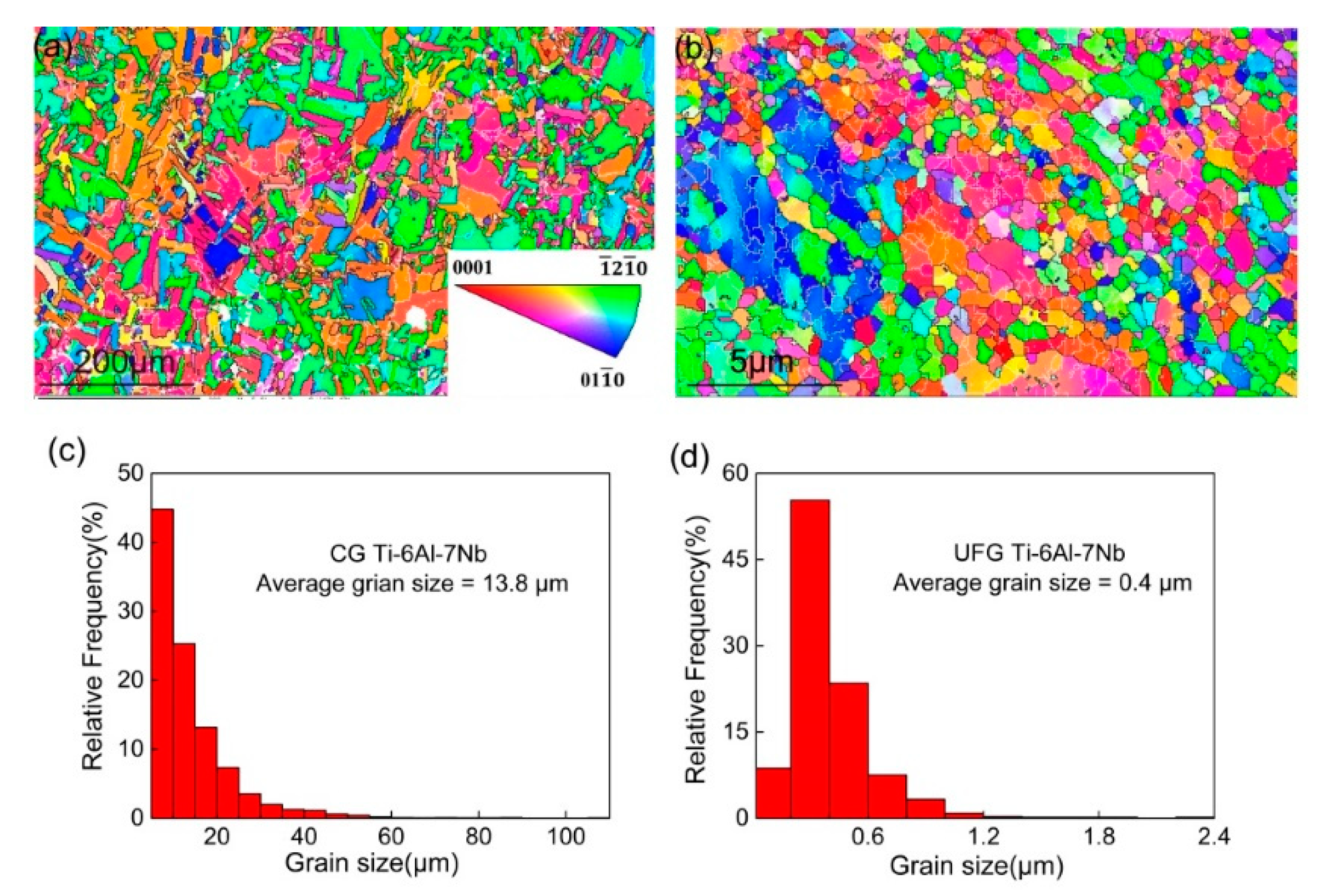
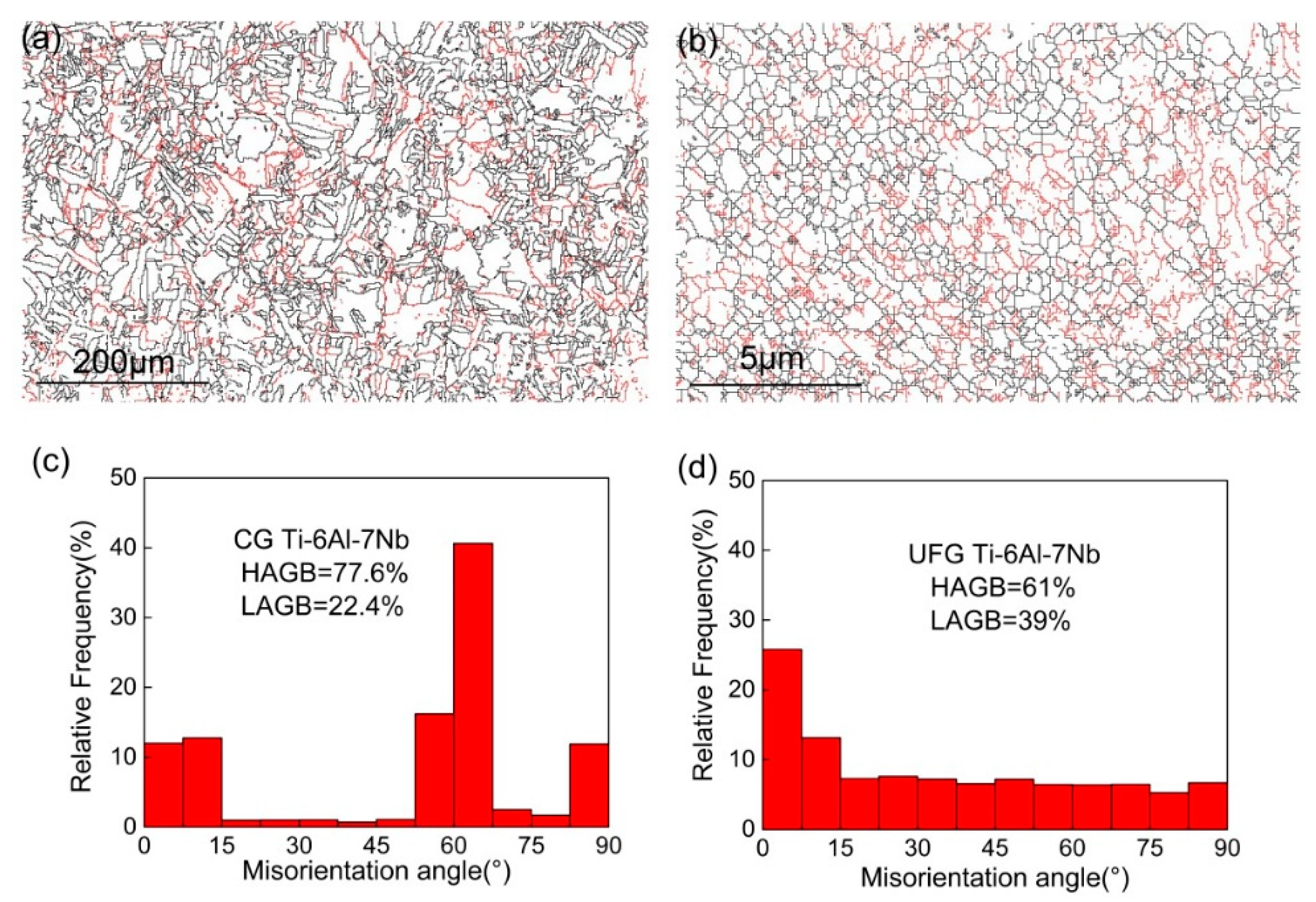
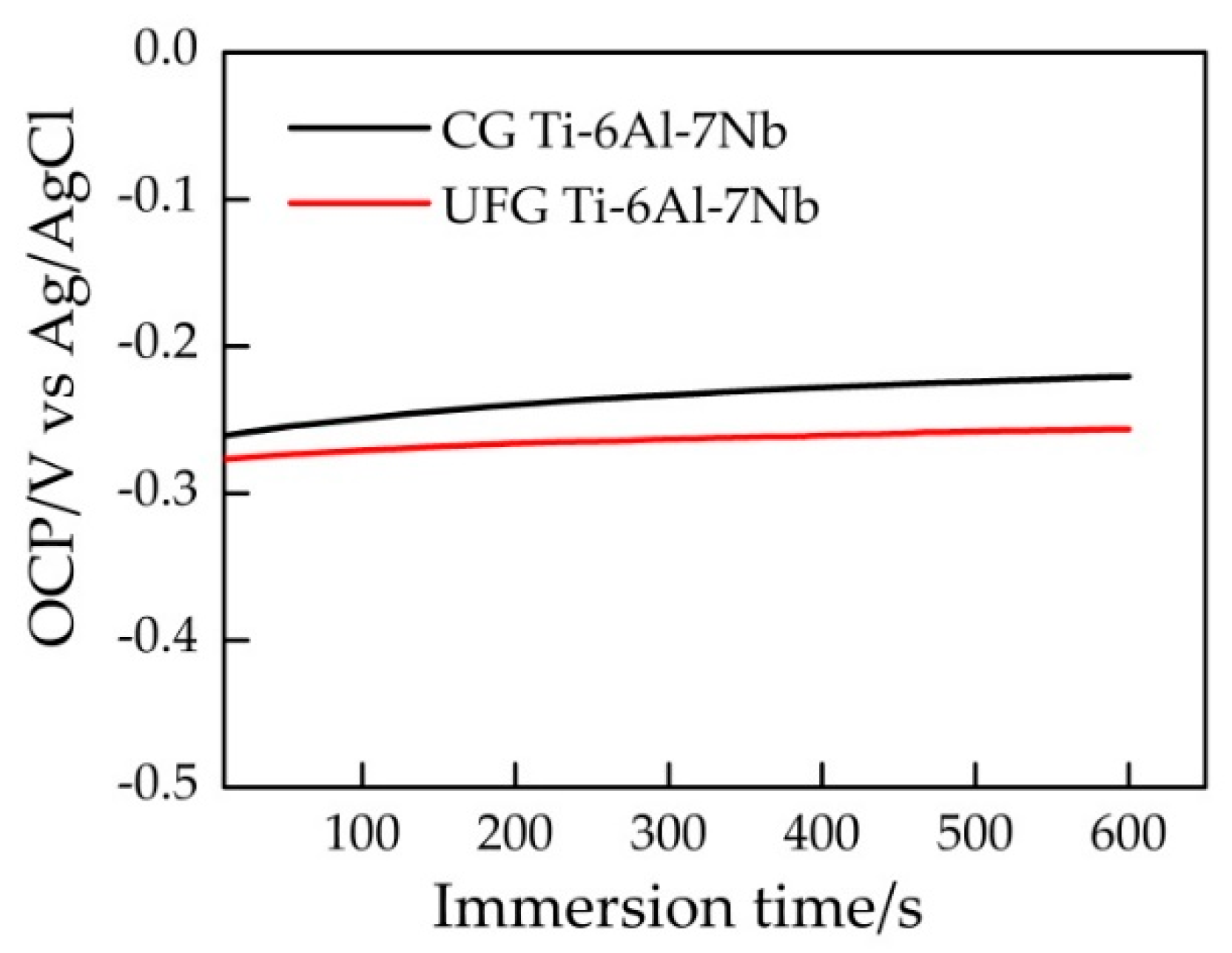
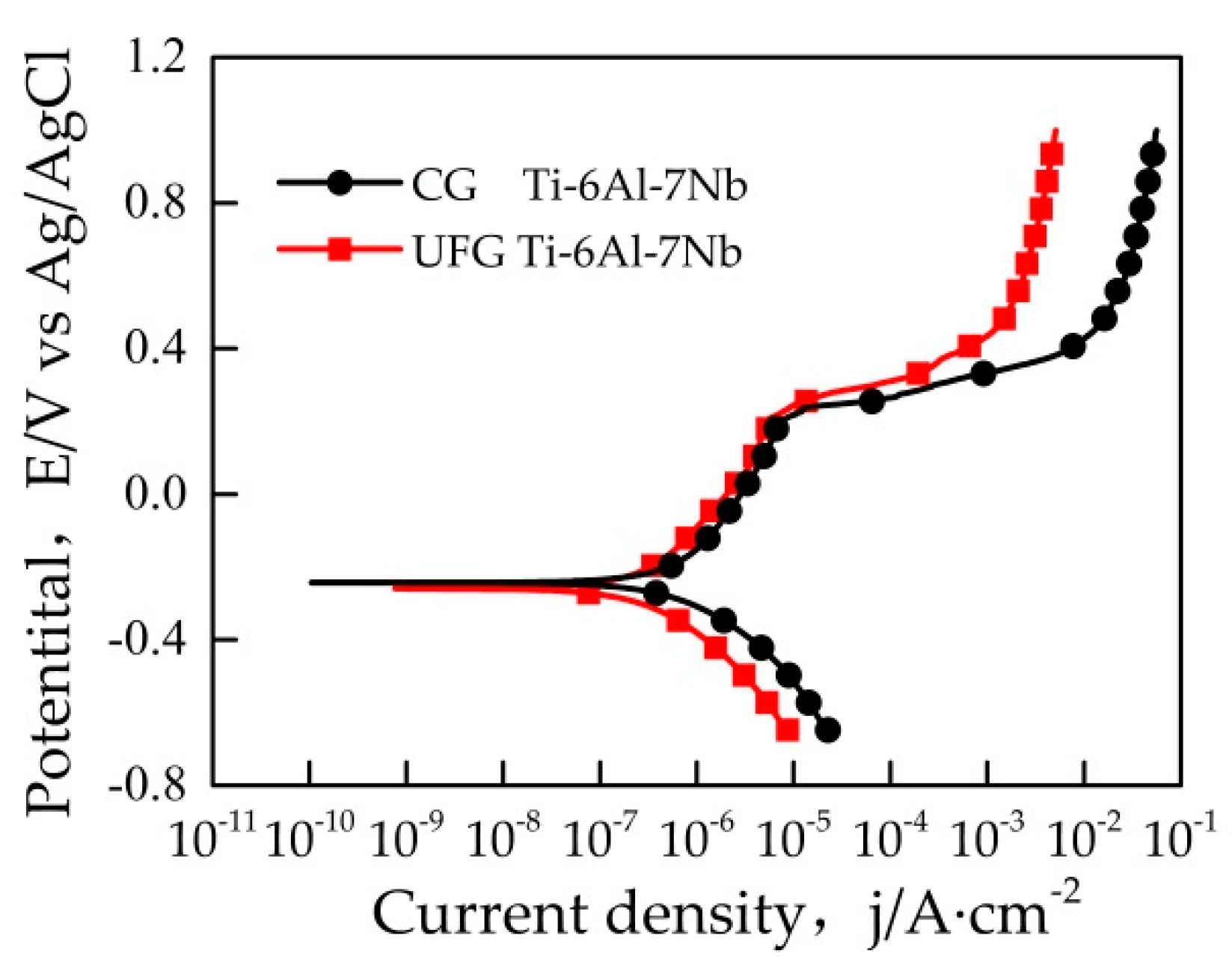
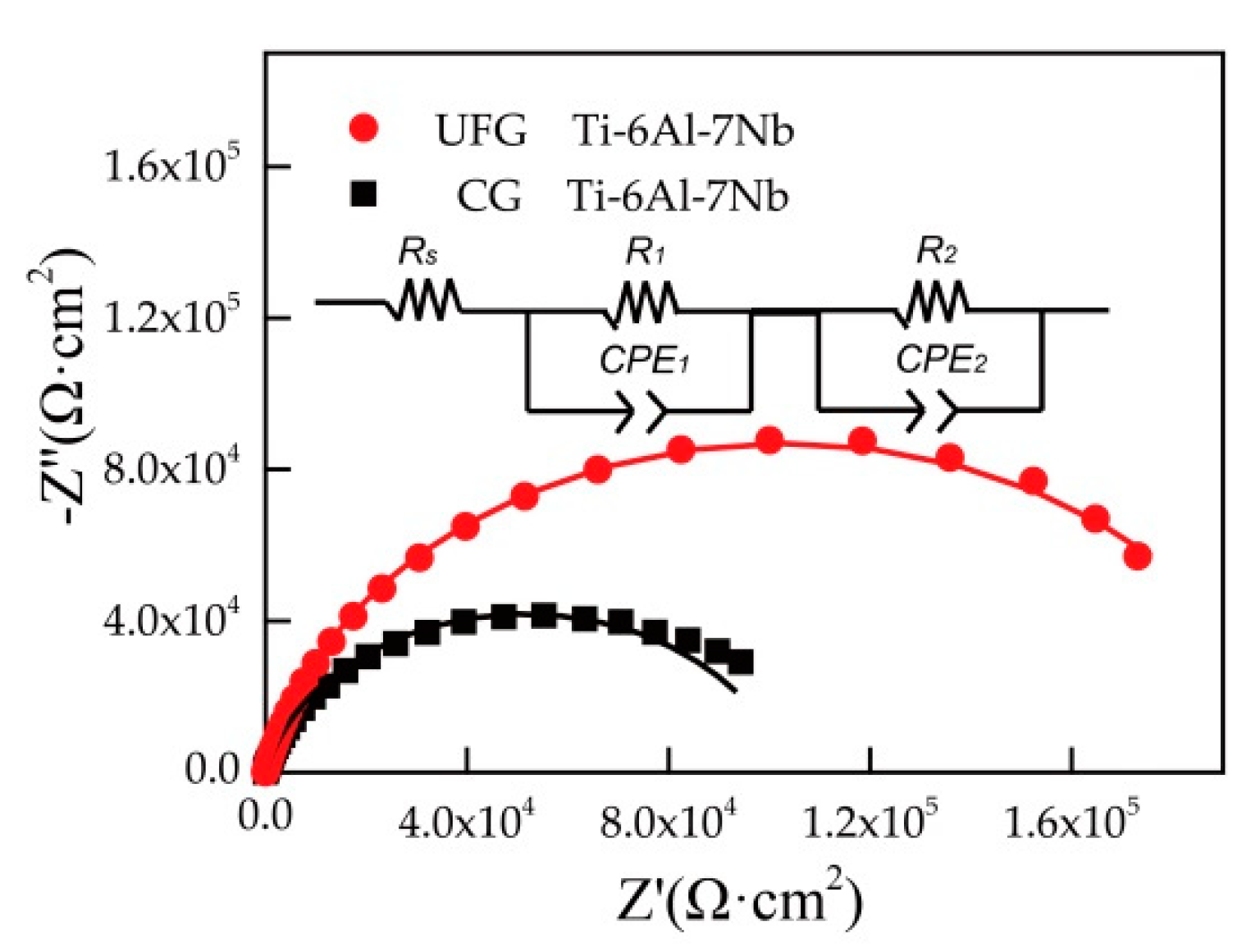
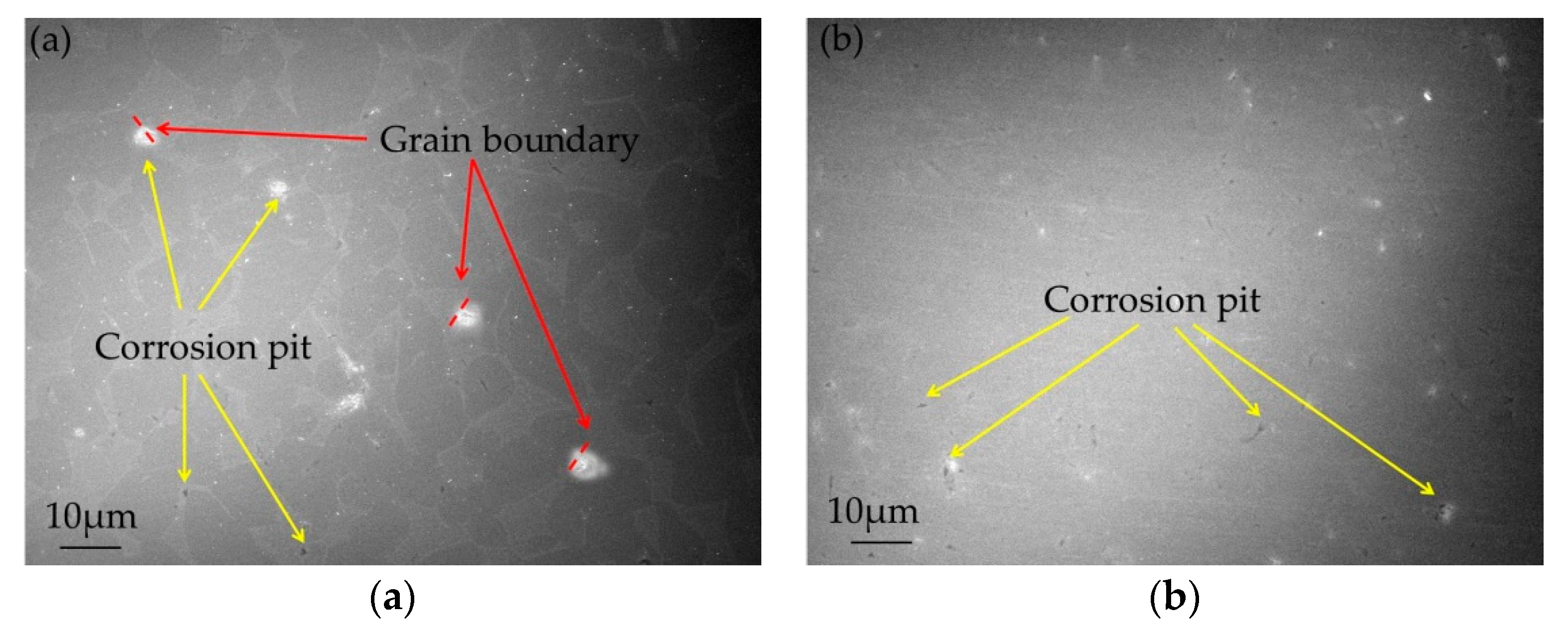

| Sample | Ecorr ((V) vs. Ag/AgCl) | Epit (V) | ipass (μA·cm−2) | icorr (μA·cm−2) | R (mm·a−1) |
|---|---|---|---|---|---|
| Coarse-Grained (CG) | −0.27 ± 0.01 | 0.33 ± 0.10 | 0.81 ± 0.25 | 0.33 ± 0.17 | 0.0028 |
| Ultrafine-Grained (UFG) | −0.29 ± 0.05 | 0.45 ± 0.10 | 0.35 ± 0.10 | 0.14 ± 0.02 | 0.0012 |
| Sample | Rs (Ω·cm2) | CPE1 (10−5 S·sn·cm2) | n1 | R1 (102Ω·cm2) | CPE2 (10−5 S·sn·cm2) | n2 | R2 (105Ω·cm2) | Rp (105Ω·cm2) |
|---|---|---|---|---|---|---|---|---|
| CG | 8.7 ± 1.7 | 8.5 ± 4.2 | 0.84 ±0.03 | 0.41 ± 0.12 | 4.7 ± 2.1 | 0.87 ± 0.01 | 1.1 ± 0.26 | 1.1 ± 0.26 |
| UFG | 12 ± 0.90 | 4.4 ± 2.9 | 0.90±0.05 | 30 ± 22 | 2.8 ± 0.31 | 0.94 ± 0.02 | 2.4 ± 0.16 | 2.4 ± 0.16 |
| Composition (%) | TiO2 | Ti | Ti2O3 | TiO | Nb2O5 | Nb | NbO | NbO2 | Al2O3 | Al |
|---|---|---|---|---|---|---|---|---|---|---|
| CG | 79.61 | 1.23 | 14.10 | 5.06 | 87.23 | 7.62 | 4.57 | 0.58 | 92.78 | 7.22 |
| UFG | 86.91 | 0.84 | 7.94 | 4.31 | 91.57 | 4.21 | 3.43 | 0.79 | 82.70 | 17.30 |
© 2020 by the authors. Licensee MDPI, Basel, Switzerland. This article is an open access article distributed under the terms and conditions of the Creative Commons Attribution (CC BY) license (http://creativecommons.org/licenses/by/4.0/).
Share and Cite
Yu, Z.; Dong, Y.; Li, X.; Niu, J.; Alexandrov, I.; Chang, H. Study on Corrosion Behavior of Ultrafine-Grained Ti-6Al-7Nb Fabricated by Equal Channel Angular Pressing. Metals 2020, 10, 950. https://doi.org/10.3390/met10070950
Yu Z, Dong Y, Li X, Niu J, Alexandrov I, Chang H. Study on Corrosion Behavior of Ultrafine-Grained Ti-6Al-7Nb Fabricated by Equal Channel Angular Pressing. Metals. 2020; 10(7):950. https://doi.org/10.3390/met10070950
Chicago/Turabian StyleYu, Zequn, Yuecheng Dong, Xin Li, Jingzhe Niu, Igor Alexandrov, and Hui Chang. 2020. "Study on Corrosion Behavior of Ultrafine-Grained Ti-6Al-7Nb Fabricated by Equal Channel Angular Pressing" Metals 10, no. 7: 950. https://doi.org/10.3390/met10070950
APA StyleYu, Z., Dong, Y., Li, X., Niu, J., Alexandrov, I., & Chang, H. (2020). Study on Corrosion Behavior of Ultrafine-Grained Ti-6Al-7Nb Fabricated by Equal Channel Angular Pressing. Metals, 10(7), 950. https://doi.org/10.3390/met10070950





